wheel alignment KIA SOUL EV 2019 Owners Manual
[x] Cancel search | Manufacturer: KIA, Model Year: 2019, Model line: SOUL EV, Model: KIA SOUL EV 2019Pages: 455, PDF Size: 15.52 MB
Page 317 of 455
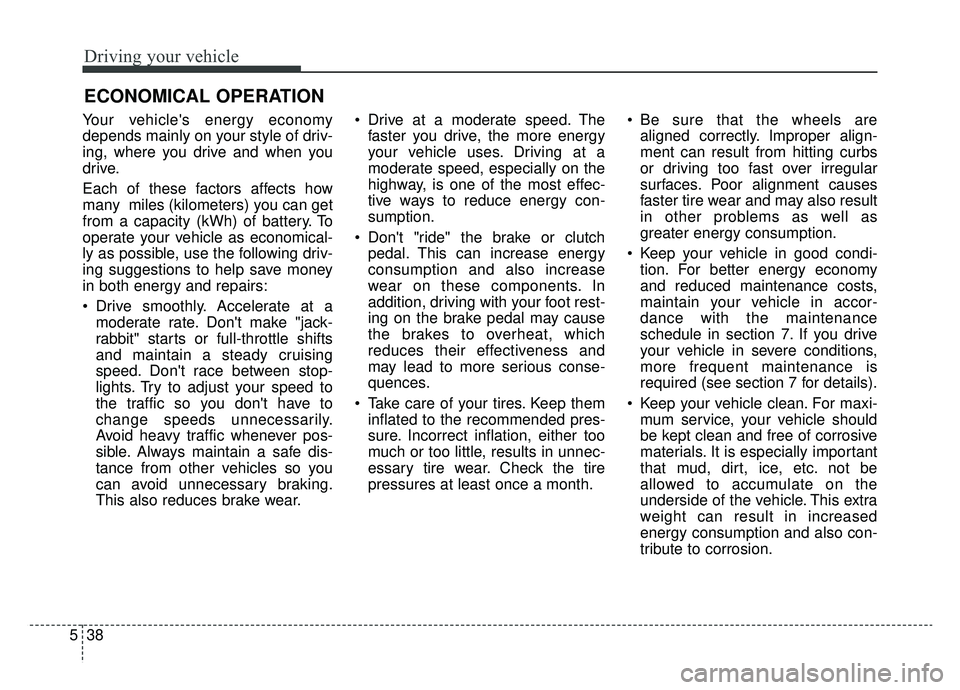
Driving your vehicle
38
5
Your vehicle's energy economy
depends mainly on your style of driv-
ing, where you drive and when you
drive.
Each of these factors affects how
many miles (kilometers) you can get
from a capacity (kWh) of battery. To
operate your vehicle as economical-
ly as possible, use the following driv-
ing suggestions to help save money
in both energy and repairs:
Drive smoothly. Accelerate at a
moderate rate. Don't make "jack-
rabbit" starts or full-throttle shifts
and maintain a steady cruising
speed. Don't race between stop-
lights. Try to adjust your speed to
the traffic so you don't have to
change speeds unnecessarily.
Avoid heavy traffic whenever pos-
sible. Always maintain a safe dis-
tance from other vehicles so you
can avoid unnecessary braking.
This also reduces brake wear. Drive at a moderate speed. The
faster you drive, the more energy
your vehicle uses. Driving at a
moderate speed, especially on the
highway, is one of the most effec-
tive ways to reduce energy con-
sumption.
Don't "ride" the brake or clutch pedal. This can increase energy
consumption and also increase
wear on these components. In
addition, driving with your foot rest-
ing on the brake pedal may cause
the brakes to overheat, which
reduces their effectiveness and
may lead to more serious conse-
quences.
Take care of your tires. Keep them inflated to the recommended pres-
sure. Incorrect inflation, either too
much or too little, results in unnec-
essary tire wear. Check the tire
pressures at least once a month. Be sure that the wheels are
aligned correctly. Improper align-
ment can result from hitting curbs
or driving too fast over irregular
surfaces. Poor alignment causes
faster tire wear and may also result
in other problems as well as
greater energy consumption.
Keep your vehicle in good condi- tion. For better energy economy
and reduced maintenance costs,
maintain your vehicle in accor-
dance with the maintenance
schedule in section 7. If you drive
your vehicle in severe conditions,
more frequent maintenance is
required (see section 7 for details).
Keep your vehicle clean. For maxi- mum service, your vehicle should
be kept clean and free of corrosive
materials. It is especially important
that mud, dirt, ice, etc. not be
allowed to accumulate on the
underside of the vehicle. This extra
weight can result in increased
energy consumption and also con-
tribute to corrosion.
ECONOMICAL OPERATION
Page 364 of 455
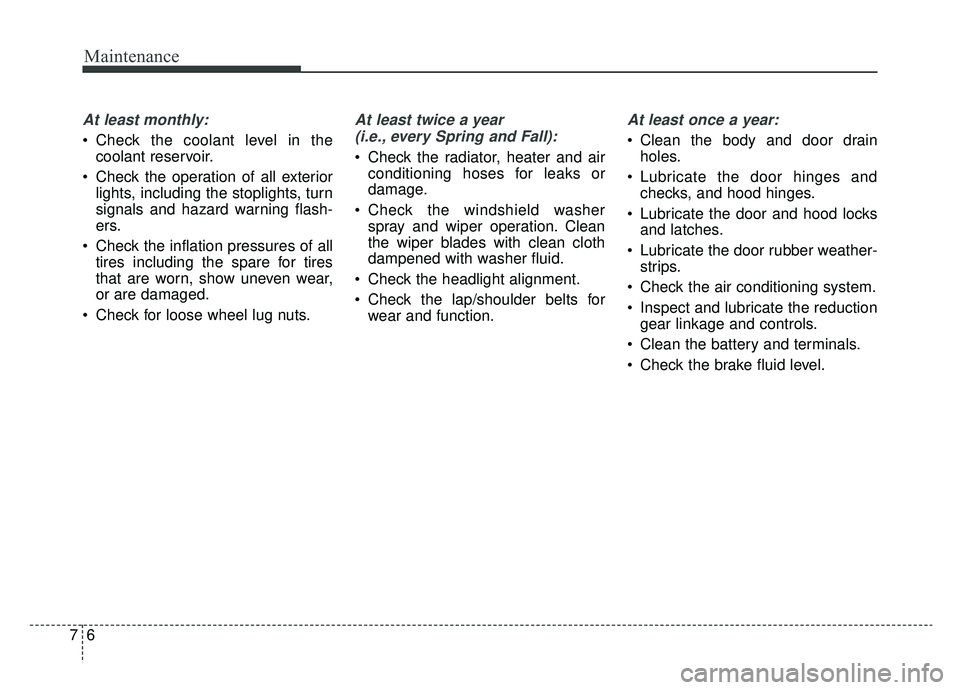
Maintenance
67
At least monthly:
Check the coolant level in thecoolant reservoir.
Check the operation of all exterior lights, including the stoplights, turn
signals and hazard warning flash-
ers.
Check the inflation pressures of all tires including the spare for tires
that are worn, show uneven wear,
or are damaged.
Check for loose wheel lug nuts.
At least twice a year (i.e., every Spring and Fall):
Check the radiator, heater and air conditioning hoses for leaks or
damage.
Check the windshield washer spray and wiper operation. Clean
the wiper blades with clean cloth
dampened with washer fluid.
Check the headlight alignment.
Check the lap/shoulder belts for wear and function.
At least once a year:
Clean the body and door drainholes.
Lubricate the door hinges and checks, and hood hinges.
Lubricate the door and hood locks and latches.
Lubricate the door rubber weather- strips.
Check the air conditioning system.
Inspect and lubricate the reduction gear linkage and controls.
Clean the battery and terminals.
Check the brake fluid level.
Page 390 of 455
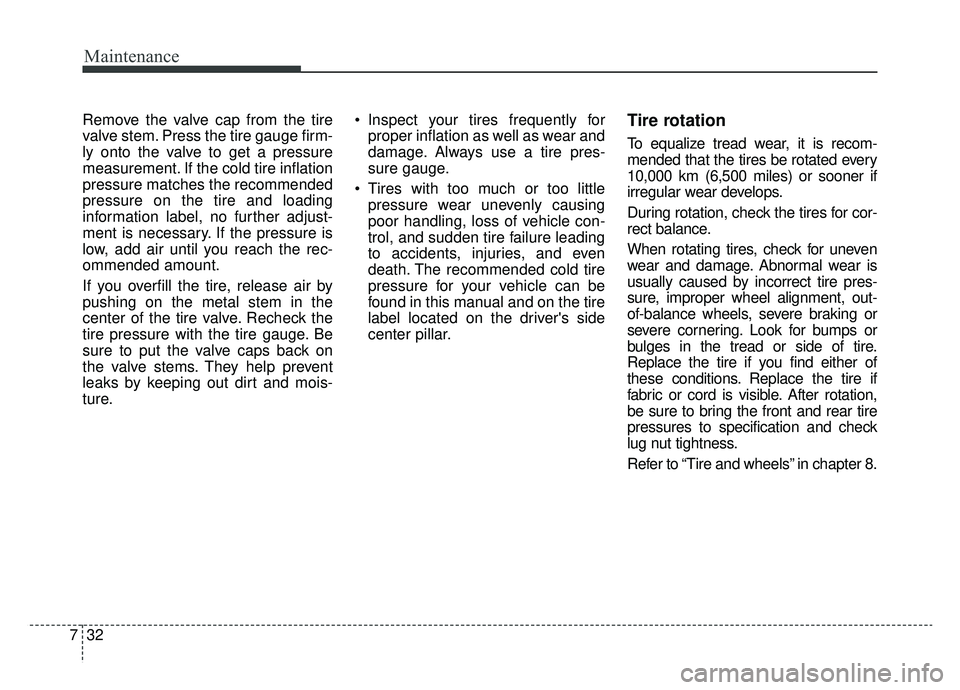
Maintenance
32
7
Remove the valve cap from the tire
valve stem. Press the tire gauge firm-
ly onto the valve to get a pressure
measurement. If the cold tire inflation
pressure matches the recommended
pressure on the tire and loading
information label, no further adjust-
ment is necessary. If the pressure is
low, add air until you reach the rec-
ommended amount.
If you overfill the tire, release air by
pushing on the metal stem in the
center of the tire valve. Recheck the
tire pressure with the tire gauge. Be
sure to put the valve caps back on
the valve stems. They help prevent
leaks by keeping out dirt and mois-
ture. Inspect your tires frequently for
proper inflation as well as wear and
damage. Always use a tire pres-
sure gauge.
Tires with too much or too little pressure wear unevenly causing
poor handling, loss of vehicle con-
trol, and sudden tire failure leading
to accidents, injuries, and even
death. The recommended cold tire
pressure for your vehicle can be
found in this manual and on the tire
label located on the driver's side
center pillar.Tire rotation
To equalize tread wear, it is recom-
mended that the tires be rotated every
10,000 km (6,500 miles) or sooner if
irregular wear develops.
During rotation, check the tires for cor-
rect balance.
When rotating tires, check for uneven
wear and damage. Abnormal wear is
usually caused by incorrect tire pres-
sure, improper wheel alignment, out-
of-balance wheels, severe braking or
severe cornering. Look for bumps or
bulges in the tread or side of tire.
Replace the tire if you find either of
these conditions. Replace the tire if
fabric or cord is visible. After rotation,
be sure to bring the front and rear tire
pressures to specification and check
lug nut tightness.
Refer to “Tire and wheels” in chapter 8.
Page 391 of 455
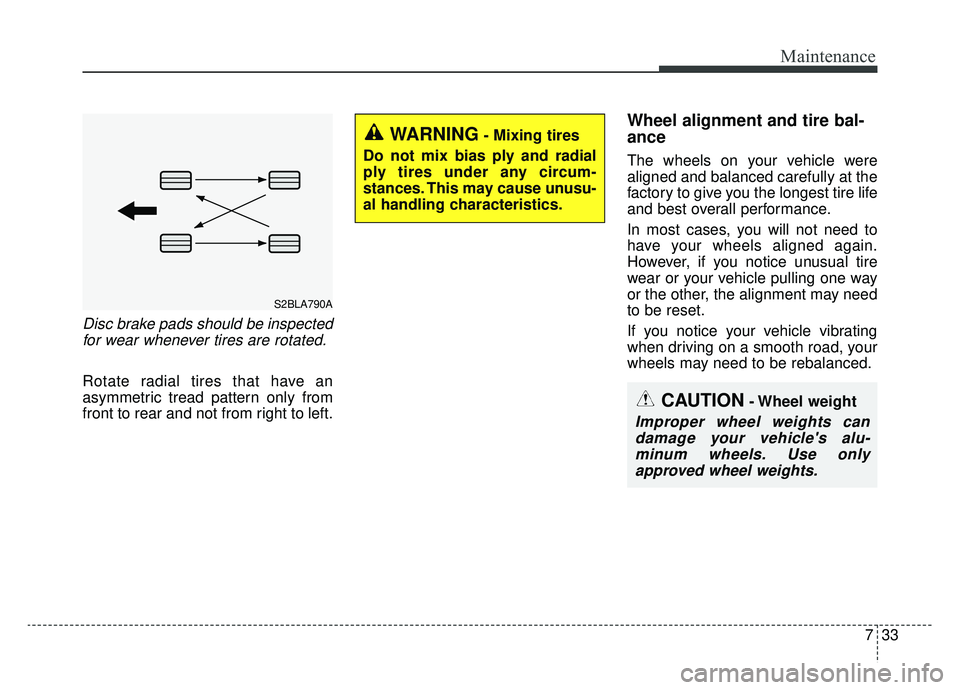
733
Maintenance
Disc brake pads should be inspectedfor wear whenever tires are rotated.
Rotate radial tires that have an
asymmetric tread pattern only from
front to rear and not from right to left.
Wheel alignment and tire bal-
ance
The wheels on your vehicle were
aligned and balanced carefully at the
factory to give you the longest tire life
and best overall performance.
In most cases, you will not need to
have your wheels aligned again.
However, if you notice unusual tire
wear or your vehicle pulling one way
or the other, the alignment may need
to be reset.
If you notice your vehicle vibrating
when driving on a smooth road, your
wheels may need to be rebalanced.
CAUTION- Wheel weight
Improper wheel weights candamage your vehicle's alu-minum wheels. Use onlyapproved wheel weights.
WARNING- Mixing tires
Do not mix bias ply and radial
ply tires under any circum-
stances. This may cause unusu-
al handling characteristics.
S2BLA790A
Page 393 of 455
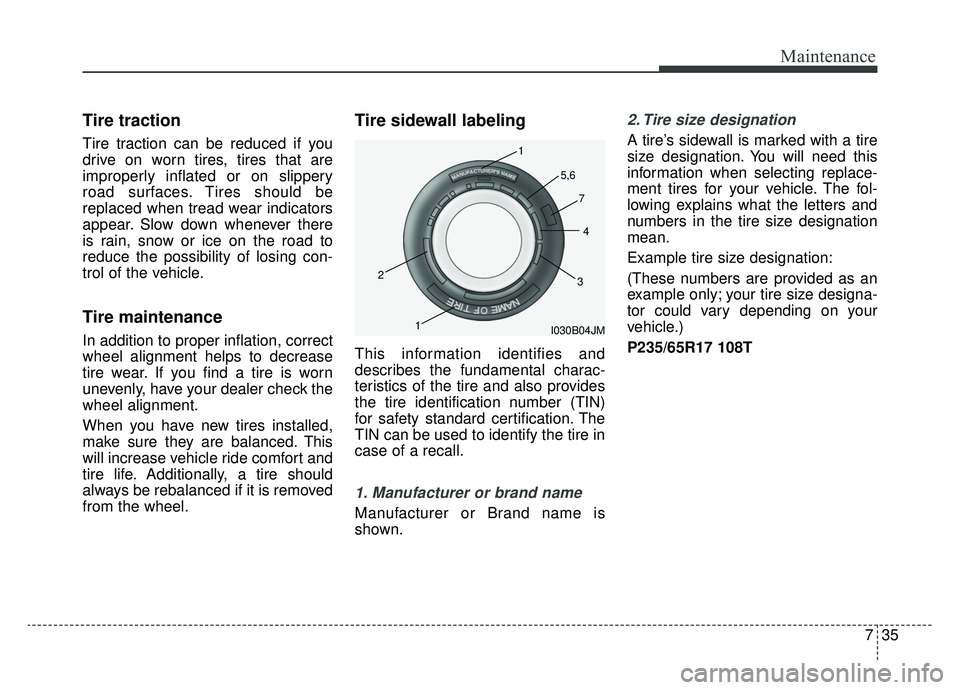
735
Maintenance
Tire traction
Tire traction can be reduced if you
drive on worn tires, tires that are
improperly inflated or on slippery
road surfaces. Tires should be
replaced when tread wear indicators
appear. Slow down whenever there
is rain, snow or ice on the road to
reduce the possibility of losing con-
trol of the vehicle.
Tire maintenance
In addition to proper inflation, correct
wheel alignment helps to decrease
tire wear. If you find a tire is worn
unevenly, have your dealer check the
wheel alignment.
When you have new tires installed,
make sure they are balanced. This
will increase vehicle ride comfort and
tire life. Additionally, a tire should
always be rebalanced if it is removed
from the wheel.
Tire sidewall labeling
This information identifies and
describes the fundamental charac-
teristics of the tire and also provides
the tire identification number (TIN)
for safety standard certification. The
TIN can be used to identify the tire in
case of a recall.
1. Manufacturer or brand name
Manufacturer or Brand name is
shown.
2. Tire size designation
A tire’s sidewall is marked with a tire
size designation. You will need this
information when selecting replace-
ment tires for your vehicle. The fol-
lowing explains what the letters and
numbers in the tire size designation
mean.
Example tire size designation:
(These numbers are provided as an
example only; your tire size designa-
tor could vary depending on your
vehicle.)
P235/65R17 108T
I030B04JM
1
1
2
34
5,6
7
Page 453 of 455
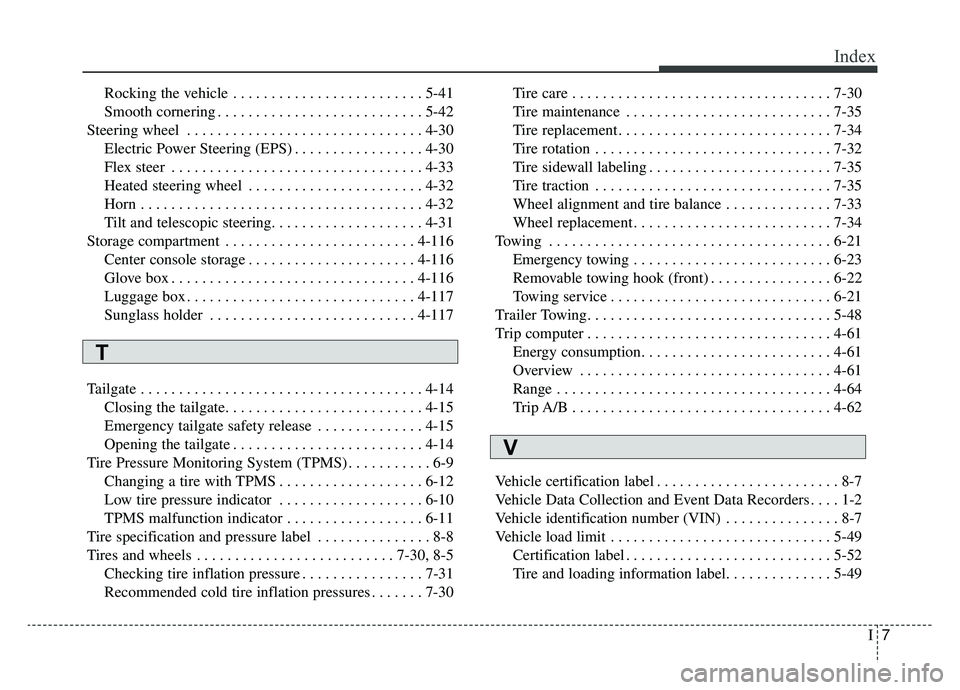
I7
Index
Rocking the vehicle . . . . . . . . . . . . . . . . . . . . . . . . . 5-41
Smooth cornering . . . . . . . . . . . . . . . . . . . . . . . . . . . 5-42
Steering wheel . . . . . . . . . . . . . . . . . . . . . . . . . . . . . . . 4-30 Electric Power Steering (EPS) . . . . . . . . . . . . . . . . . 4-30
Flex steer . . . . . . . . . . . . . . . . . . . . . . . . . . . . . . . . . 4-33
Heated steering wheel . . . . . . . . . . . . . . . . . . . . . . . 4-32
Horn . . . . . . . . . . . . . . . . . . . . . . . . . . . . . . . . . . . . \
. 4-32
Tilt and telescopic steering. . . . . . . . . . . . . . . . . . . . 4-31
Storage compartment . . . . . . . . . . . . . . . . . . . . . . . . . 4-116 Center console storage . . . . . . . . . . . . . . . . . . . . . . 4-116
Glove box . . . . . . . . . . . . . . . . . . . . . . . . . . . . . . . . 4-116
Luggage box . . . . . . . . . . . . . . . . . . . . . . . . . . . . . . 4-117
Sunglass holder . . . . . . . . . . . . . . . . . . . . . . . . . . . 4-117
Tailgate . . . . . . . . . . . . . . . . . . . . . . . . . . . . . . . . . . . . \
. 4-14 Closing the tailgate. . . . . . . . . . . . . . . . . . . . . . . . . . 4-15
Emergency tailgate safety release . . . . . . . . . . . . . . 4-15
Opening the tailgate . . . . . . . . . . . . . . . . . . . . . . . . . 4-14
Tire Pressure Monitoring System (TPMS) . . . . . . . . . . . 6-9 Changing a tire with TPMS . . . . . . . . . . . . . . . . . . . 6-12
Low tire pressure indicator . . . . . . . . . . . . . . . . . . . 6-10
TPMS malfunction indicator . . . . . . . . . . . . . . . . . . 6-11
Tire specification and pressure label . . . . . . . . . . . . . . . 8-8
Tires and wheels . . . . . . . . . . . . . . . . . . . . . . . . . . 7-30, 8-5 Checking tire inflation pressure . . . . . . . . . . . . . . . . 7-31
Recommended cold tire inflation pressures . . . . . . . 7-30 Tire care . . . . . . . . . . . . . . . . . . . . . . . . . . . . . . . . . . 7-30\
Tire maintenance . . . . . . . . . . . . . . . . . . . . . . . . . . . 7-35
Tire replacement . . . . . . . . . . . . . . . . . . . . . . . . . . . . 7-34
Tire rotation . . . . . . . . . . . . . . . . . . . . . . . . . . . . . . . 7-32
Tire sidewall labeling . . . . . . . . . . . . . . . . . . . . . . . . 7-35
Tire traction . . . . . . . . . . . . . . . . . . . . . . . . . . . . . . . 7-35
Wheel alignment and tire balance . . . . . . . . . . . . . . 7-33
Wheel replacement . . . . . . . . . . . . . . . . . . . . . . . . . . 7-34
Towing . . . . . . . . . . . . . . . . . . . . . . . . . . . . . . . . . . . . \
. 6-21 Emergency towing . . . . . . . . . . . . . . . . . . . . . . . . . . 6-23
Removable towing hook (front) . . . . . . . . . . . . . . . . 6-22
Towing service . . . . . . . . . . . . . . . . . . . . . . . . . . . . . 6-21
Trailer Towing. . . . . . . . . . . . . . . . . . . . . . . . . . . . . . . . 5-48
Trip computer . . . . . . . . . . . . . . . . . . . . . . . . . . . . . . . . 4-61 Energy consumption. . . . . . . . . . . . . . . . . . . . . . . . . 4-61
Overview . . . . . . . . . . . . . . . . . . . . . . . . . . . . . . . . . 4-61
Range . . . . . . . . . . . . . . . . . . . . . . . . . . . . . . . . . . . . \
4-64
Trip A/B . . . . . . . . . . . . . . . . . . . . . . . . . . . . . . . . . . 4-62\
Vehicle certification label . . . . . . . . . . . . . . . . . . . . . . . . 8-7
Vehicle Data Collection and Event Data Recorders . . . . 1-2
Vehicle identification number (VIN) . . . . . . . . . . . . . . . 8-7
Vehicle load limit . . . . . . . . . . . . . . . . . . . . . . . . . . . . . 5-49 Certification label . . . . . . . . . . . . . . . . . . . . . . . . . . . 5-52
Tire and loading information label. . . . . . . . . . . . . . 5-49
T
V